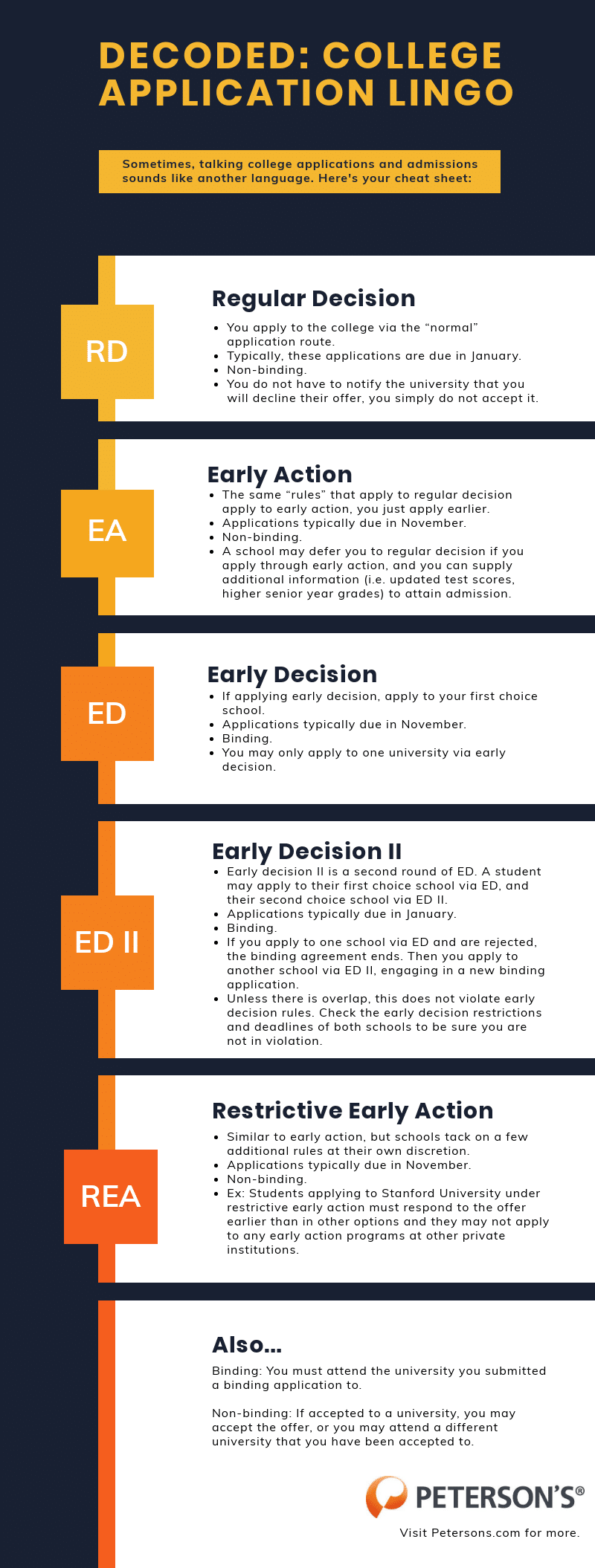Early action versus regular decision is a hotly debated choice that every college applicant has to make. While many swear that choosing one admissions route over another allowed or prevented them from getting into a university, the benefits and consequences depend on your personal situation, application, and desired colleges.
This article features university perspectives as well as senior mentor insight to give you the facts–and dispel the myths–of application timing. Read on to find out which route is best for you.
FACT #1: Colleges prefer that you apply early.
Yes, this is a thing. The main reason colleges offer two application cycles is to space things out for the admissions officers so they can look at individual applications more extensively, as well as have more time to evaluate an incoming class as a whole. Colin Pfeiffer, a Senior Mentor at Admissionado, explains the benefit to the school in terms of building a cohort that will be the most successful at the university.
“Early action and early decision gives [colleges] the opportunity to see what’s out there,” said Pfeiffer. Actually sitting down with those ED applicants and seeing what the class has to offer is really instructive for what kind of class they want to be building over the course of the year.”
There are other factors that go into whether you should apply early or not, but if you have the option to submit a stellar application either way, colleges say to go for it and get your application submitted ASAP.
“If a student is asking and saying [they] just don’t know what to do, we’d like to have them apply earlier because it allows us more time during their senior year to work with them to get any additional information we might need,” said Kevin MacLennan, Assistant Vice Chancellor of Enrollment Management at the University of Colorado, Boulder.
MYTH #1: All colleges and universities use the same early action processes.
This is where things get tricky and you will have to do your research. There are multiple modes of early action, which vary by school. For example, a state school like CU Boulder uses a simple early action model, where there are two application deadlines: early action and regular decision. Early action at CU is non-binding, but at nearby University of Denver, a private school, there are four application options, two of which are binding. Make sure you understand the application rules of each college you’re applying to before you accidentally jeopardize your application by violating restrictions.
Generally, the more selective or private an institution is, the more extensive and strict application policies are. These universities assume they will be higher on your “wish list”, so they can afford to make these types of restrictions. On the other hand, public, state schools that tend to be less exclusive have more consistent rules when it comes to early action. There are many state schools that are highly selective, yet the application model is much less extensive. University of California system schools have a acceptance rates as low as 16 percent, but most do not offer any early action processes. Other state schools that do offer early action tend to adopt plans similar to CU Boulder.
FACT #2: Fewer students apply through early action than regular decision.
The restriction of binding rules and an earlier deadline prevents the bulk of applicants from applying under early action programs. However, this does not always guarantee less competition and higher chance of admittance.
“We want to be fair to applicants throughout the process so when students are applying across the year, our admissions requirements don’t change,” said MacLennan in regards to how CU Boulder views both EA and RD applicants, “we look at that whole pool together.”
Statistics do show correlation between admittance to universities and early applicants, but this does not take into account higher credentials of early applicants or likelihood that early applications are to an applicant’s top choice school, causing incentive to perfect the application. This is why early action is encouraged, but waiting for regular decision does not necessarily decrease your admittance odds.
“It’s about balance and making sure that you’re able to take the people that you’re really excited about, but that you’re also saving room for when regular decision rolls around and you get even more incredible candidates from the pipeline,” said Pfeiffer from a university admissions standpoint.
MYTH #2: You can apply to multiple schools via early decision.
This is a big college application no-no. Early decision applications are binding, so sending multiple applications through early decision may mean you will end up legally bound to attend multiple universities. Plus, this will threaten your chances of getting into these institutions in the first place as colleges communicate with each other to ensure this doesn’t happen.
Pfeiffer explained that parents and students sometimes assume “there are no consequences to applying to multiple schools early decision, which is not true. They’ll figure it out and you’re going to lose all credibility and not be able to get in anywhere,” said Pfeiffer.
However, you do not have to go to a school if you get accepted there through early action, as this process functions similarly to regular decision with an early deadline.
FACT #3: You should wait to apply if your application will be stronger for regular decision.
If you are trying to boost your GPA, waiting to submit your college applications until grades from the first semester of your senior year are available might be the right choice for you. You also may be retaking the SAT or ACT, and will want to wait until the scores are available to report a potentially higher score to your chosen colleges. Another situation where utilizing extra time would be beneficial is if you have not done enough research on potential colleges. You may not be well informed on the schools to which you are applying. Make sure you don’t waste your time and money applying to schools you are not actually interested in.
“See if it makes sense rather than trying to cram something in that’s not going to reflect well on you,” said Pfeiffer, “there’s no point in sending the application fee if its only to receive a rejection.”
MYTH #3: If you don’t get admitted right away through early action, you aren’t getting in.
In many cases, applying early allows the school to work with you. If you are right on the cusp of being admitted, the school may still want to admit you if you can supply information that will strengthen you application. They may request additional information such as senior year grades, updated test scores, or other proof of academic, extracurricular, and collegiate merit.
“If we saw that you were doing some additional things to strengthen your record, we would actually request to see those before we made a final decision,” said MacLennan.
When it comes down to it, choosing which application path is right for you is pretty simple: if you’re ready, apply early, if not, don’t rush it, and, be sure to play by the rules. There are a lot of opinions, deadlines, and differing restrictions out there that can seem overwhelming. However, taking the time to understand how the schools you’ve chosen to apply to work can space out your application timeline and prioritize your top-choice schools. If you don’t understand something about the specifics of your applications, talking to your high school guidance counselor or contacting the school directly will clear things up.
“At the end of the day the goal is to get admitted somewhere,” said Pfeiffer, “making sure that you are presenting the best version of your accomplishments and yourself to the admissions officers is the key, and if you can do that early, then fantastic. But, if you can’t do it as early as you want to and you need to wait until the second round, then that’s OK too.”
Not following some of the terms? Use this infographic for reference:

See also: Applying Early: Your Early Decision Options Defined
Need help getting started on your college search? Search by location, major, admission difficulty, and more with Peterson’s College Search.



